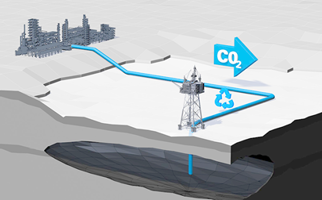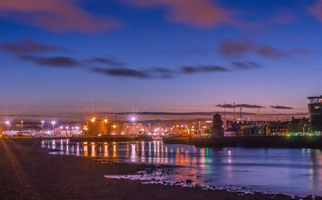
-
21 licences shared by a total of 14 companies
-
Almost 10% of total UK greenhouse gas emissions could be stored in new licence locations
-
Bacton could be Energy Transition Hub – home to carbon storage, offshore wind, and hydrogen production
The North Sea Transition Authority (NSTA) today (15 September 2023) announced the list of companies which have accepted licences following the UK’s first-ever carbon storage licensing round.
A total of 14 companies have been awarded 21 licences in depleted oil and gas reservoirs and saline aquifers which cover around 12,000sq km – an area equivalent to the size of Yorkshire.
The locations could store up to 30 million tonnes of CO2 per year by 2030, approximately 10% of UK annual emissions which were 341.5 million tonnes in 2021.
Shell, Perenco and ENI have all been awarded licences off the coast of Norfolk in sites which could form part of the Bacton Energy Hub – a carbon storage, hydrogen and offshore wind project, which could provide low-carbon energy for London and the South East for decades to come and help in the drive to net zero greenhouse gas emissions.
Other locations include sites off the coasts of Aberdeen, Teesside, and Liverpool.
Stuart Payne, NSTA Chief Executive, said:
“Carbon storage will play a crucial role in the energy transition, storing carbon dioxide deep under the seabed and playing a key role in hydrogen production and energy hubs.
“It is exciting to award these licences and our teams will support the licensees to bring about first injection of carbon dioxide as soon as possible. We will also continue to work with industry and government to enable further licensing activity and back the UK’s drive to net zero emissions.”
It is estimated that as many as 100 storage licences will be needed to meet the requirements for reaching net zero and the volume of applications received for the first round demonstrated the industry’s desire for further opportunities.
The NSTA will assess the response and the quality of opportunities in locations across the UK before deciding when to run a second round.
Six licences have already been granted by the NSTA and the Government recently announced £20bn funding for the progression of these existing projects. Two locations, Hynet and the East Coast Cluster, have been selected as Track 1, while Acorn and Viking CCS projects have been chosen as the Track 2 clusters.
The cluster sequencing process was set up to give industry the certainty it requires to deploy carbon storage at pace.
An updated GIS delivery is available here, and redacted versions of all of the new licences will be published in the coming days.
Ruth Herbert, Chief Executive at the Carbon Capture and Storage Association, said:
“The CCSA welcomes the acceptance of carbon storage licences, a significant step towards achieving net zero. These licences mark a substantial milestone towards widespread deployment of CCS.
“With the potential to store almost 10% of the UK's greenhouse gas emissions in these new locations, starting to develop these sites paves the way for a cleaner and more sustainable future. The next step is a carbon capture deployment plan to enable us to fully exploit our future CO2 storage capacity.”
Lord Callanan, Minister for Energy Efficiency and Green Finance, said:
“The UK has one of the largest potential carbon dioxide storage capacities in Europe, putting us in prime position to be world leaders in carbon capture – which is why we’ve committed an unprecedented £20 billion to develop the early stage development of carbon capture, usage and storage (CCUS).
“These new licences confirmed today will be vital to realising our CCUS potential, playing a key role in the energy transition to help boost our energy security and achieve our net zero targets, while also bringing in private investment and supporting thousands of jobs.”
The NSTA, The Crown Estate (TCE) and Crown Estate Scotland (CES) are working in close collaboration to help meet the UK Government’s ambitious carbon storage targets of 20-30 million tonnes of CO2 emissions per year by 2030, and over 50 million tonnes by 2035, and make a significant contribution to net zero.
Details of Licensees
| Licence number | Licensee | Partners (where applicable | Area | Other info (Area of interest) |
|---|---|---|---|---|
| CS008 | ENI UK Ltd | SNS | SNS Area 4 Hewett Area | |
| CS009 | Perenco UK Ltd | Carbon Catalyst Ltd | SNS | SNS Area 4 Leman Area |
| CS010 | Spirit Energy Production UK Ltd | EIS | EIS Area 1 Morecambe Area | |
| CS011 | Pale Blue Dot Energy Ltd | Shell UK Ltd; Chrysaor Ltd | CNS | CNS Area 2 Acorn East |
| CS012 | Pale Blue Dot Energy Ltd | Shell UK Ltd; Chrysaor Ltd | CNS | CNS Area 1 East Mey |
| CS013 | Enquest CCS Ltd | NNS | NNS Area 1 Magnus sub area | |
| CS014 | Enquest CCS Ltd | NNS | NNS Area 1 Thistle sub area | |
| CS015 | Enquest CCS Ltd | NNS | NNS Area 2 Tern sub area | |
| CS016 | Enquest CCS Ltd | NNS | NNS Area 2 Eider sub area | |
| CS017 | Perenco UK Ltd | Carbon Catalyst Ltd | SNS | SNS Area6B Amethyst |
| CS018 | Perenco UK Ltd | Carbon Catalyst Ltd | SNS | SNS Area 6A West Sole |
| CS019 | Synergia Energy CCS Ltd | Wintershall Dea Carbon Management Solutions UK | SNS | SNS Area 4 Camelot Area |
| CS020 | Neptune Energy CCS Projects Ltd | SNS | SNS Area 1 BC05 sub area | |
| CS021 | Neptune Energy CCS Projects Ltd | Esso Exploration and Production UK Ltd | SNS | SNS Area 5 Bunter BC13 |
| CS022 | Neptune Energy CCS Projects Ltd | SNS | SNS Area 7 Caister Bunter | |
| CS023 | Chrysaor Production UK Ltd | BP Exploration Operating Company Ltd | SNS | SNS Area 4 Vulcan area |
| CS024 | Chrysaor Production UK Ltd | BP Exploration Operating Company Ltd | SNS | SNA Area 8 Audrey |
| CS025 | BP Exploration Operating Company Ltd | Equinor New Energy Ltd | SNS | SNS Area 1 BC42 sub area |
| CS026 | Shell UK Ltd | Esso Exploration & Production UK Limited | SNS | SNS Area 2 Sean Fields |
| CS027 | Shell UK Ltd | Esso Exploration & Production UK Limited | SNS | SNS Area 2 Indefatigable field |
| CS028 | Shell UK Ltd | Exploration & Production UK Limited | SNS | SNS Area 3 |
Notes to editors:
- Bacton business opportunity
- Summit Energy Evolution
- The OGA (now NSTA), in collaboration with BEIS (now DESNZ), Ofgem and The Crown Estate, published an Energy Integration report in August 2020. The report found that offshore energy integration can deliver 30% of UK’s net zero target. It also highlighted the potential for offshore renewables to contribute around a further 30%. Work has now begun on a follow-up project looking at ways to remove barriers to projects and improve regulatory coordination.
- The 10-point plan for a green industrial revolution
- Energy White Paper: Powering our net zero future
- British Energy Security Strategy
- Spring Budget 2023 (confirming up to £20bn funding for CCUS projects)
- Huge net zero boost as 20 carbon storage licences offered for award
- NSTA offers additional carbon storage licence
- Once a licence has been awarded by the NSTA, the licensee also needs to obtain a seabed lease from The Crown Estate or Crown Estate Scotland. The Crown Estate is working to design and deliver the required leasing process for CCUS developers in England, Wales and Northern Ireland, ensuring a holistic view is taken of how new infrastructure sits alongside all other marine users and respects the nation’s vital coastal environments and habitats.
- NSTA, TCE and CES announce renewed collaboration to unlock the potential of carbon storage
Bacton
Among the benefits the Bacton Energy Hub could bring are:
- Bacton wind farms could produce nearly 40% of the Government’s 40GW by 2030 target. There is potential for very significant hydrogen demand in the Bacton Catchment Area
- By 2030 this could be the equivalent of almost 20% of the Government’s UK wide target of 5GW of low-carbon production by 2030,
- and rising tenfold by 2050.
- Decarbonising energy in the Bacton Catchment Area by using blue hydrogen with Carbon Capture and Storage could result in an emissions reduction equivalent to:
- nearly 15% of the 10-point plan’s target to remove 10MT of carbon dioxide by 2030
- and up to a 70% reduction of the regional emissions by 2050.
- Decarbonising the Bacton Catchment Area could capture carbon dioxide equivalent of:
- 700,000 cars’ worth of annual emission by 2030 and
- equivalent of 8.7 million cars emissions by 2050.
The project has already made significant progress with a series of Special Interest Groups producing highly-positive reports into various aspects of the scheme and Summit Energy Evolution and Progressive Energy Limited have already signed a joint development agreement relating to a CCS-Enabled Hydrogen Production Facility located in the vicinity of the Bacton gas terminals.
For further information please contact:
Tel: 07785 655620


